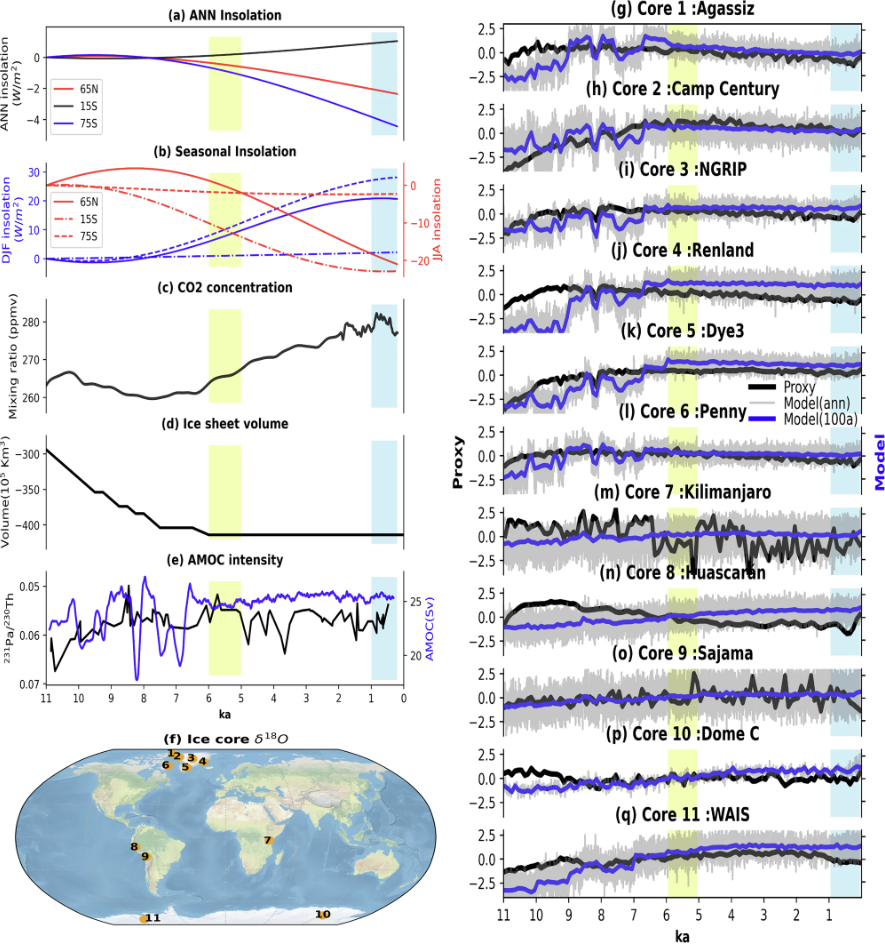Scientists Investigate Climate Model Discrepancies in Tropical Mountain Ice Cores
A new study published in Nature's Communications Earth & Environment highlights a discrepancy in Holocene climate models, particularly over tropical mountains.
The research, led by Byrd Center's Postdoctoral scholar, Yuntao Bao, in the Department of Geography at The Ohio State University, compared ice core-derived oxygen isotope records with climate simulations to investigate long-term temperature trends. The findings highlight significant inconsistencies that challenge existing climate models and call for a reassessment of paleoclimate reconstructions.
The study, co-authored by Byrd Center Principal Investigator, Max Thomas Professor of Climate Dynamics and Atmospheric Sciences Program Director Zhengyu Liu, along with Byrd Center Senior Research Scientists and Distinguished University Professors Lonnie Thompson (Earth Sciences) and Ellen Mosley-Thompson (Geography), highlights a significant conundrum in paleoclimate science. Additional contributors include Lingfeng Wan from the Frontier Science Center for Deep Ocean Multispheres and Earth System and Physical Oceanography Laboratory, Ocean University of China, and Jiuyou Lu from Laoshan Laboratory, Qingdao, China.
The Holocene epoch, spanning approximately 11,700 years, is generally characterized by a stable and warm climate. However, the study reveals key differences between climate model results and ice core-derived data. While Greenland and West Antarctic records align relatively well (with a few notable exceptions ie., Agassiz and Renland ice cores) with model simulations, a major divergence occurs in tropical mountain regions, such as the Peruvian Andes and Tanzania’s Mount Kilimanjaro. Specifically, proxy data from the tropical ice cores indicate an apparent decline in the oxygen isotope ratio values from early Holocene, suggesting a possible cooling. Conversely, climate models show a slight increase trend, contradicting the observational evidence.

This mismatch raises questions about the accuracy of climate models in capturing temperature trends in the tropics. Since tropical glaciers are particularly sensitive to temperature shifts, resolving this discrepancy is crucial for improving future climate projections. The study utilized an isotope-enabled Earth system model, iTRACE, to simulate oxygen isotope variations over the Holocene. The model outputs were then compared with the ice core-derived records. The results demonstrated that while the model effectively captures trends in polar regions, it may significantly underestimate the cooling observed in tropical mountains.
This direct model-data comparison indicates that climate models may be missing important forcings or failing to capture some physical processes in the tropics. Existing climate models may require substantial improvements in their representation of tropical climate dynamics. This is essential for reducing uncertainties in long-term climate projections.
In addition to model-data mismatch, the underlying drivers of the decreasing oxygen isotope values over the tropical mountain remain puzzling. The researchers propose several hypotheses to explain this puzzling issue and point out that both temperature and precipitation signal may play important roles in driving the changes in tropical mountain oxygen isotope during the Holocene period.
This work highlights the complexity of reconstructing past climates. By addressing the model deficiencies, scientists can refine their understanding of how tropical regions have responded to climate shifts in the past, which is critical for predicting future changes. The findings of this study are expected to stimulate further research aimed at improving both the interpretation of paleoclimate data and the performance of climate model simulations, particularly in tropical regions where climate models face the most significant challenges. With continued advancements in climate modeling and ice core analysis, researchers aspire to reconcile differences between simulated and observed climate trends, ultimately improving the reliability of future climate predictions.
Read more about the study by visiting "Climate simulations and ice core data highlight the Holocene conundrum over tropical mountains."
